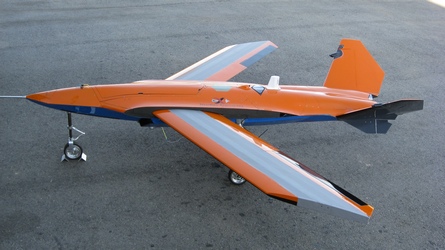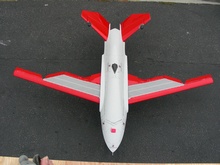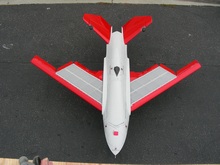NextGen Aeronautics has completed the first autonomous flights of a morphing unmanned air vehicle. The MFX-2 technology demonstrator UAV is capable of independently varying wing area and sweep.
The tests are part of a US Defense Advanced Research Projects Agency-sponsored demonstration of morphing technology for a hunter-killer UAV combining the loiter endurance of a surveillance platform with the high-speed dash capability of an attack aircraft.
Previously Torrance, California-based NextGen demonstrated its flexible-skin morphing wing using a small low-speed, remotely piloted vehicle called the MFX-1. The second-generation MFX-2 is a twin-jet, 135kg (300lb) UAV than can be switched between remote and autonomous control in flight.

NextGen's MFX-2 - grey areas are morphing panels ©NextGen Aeronautics
An articulating structure and flexible skin enables a 40% change in wing area, 73% change in span and 177% change in aspect ratio, says NextGen. Unlike conventional variable-geometry wings, morphing allows area and sweep to be varied independently to optimise the configuration for multiple flight regimes.
The MFX-2 demonstrated autonomous in-flight morphing in a series of flights at the Camp Roberts military test facility in California, says NetGen. In five flights each of around 10min, the UAV morphed while holding attitude and heading and also while turning. Morphing from one configuration to another took about 10s.
One goal of the DARPA programme is to demonstrate fast morphing for aggressive manoeuvring, and NextGen says the turn-radius ratio between extreme configurations was well above two, meaning that morphing more than doubled the turn performance.
Although similar in configuration, the MFX-2 has a simpler wing design than the original single-jet, 45kg MFX-1, which had a "W-shaped" trailing edge. Also a model of a full-scale morphing UAV using a similar serrated wing design was tested in NASA's transonic dynamics windtunnel at speeds up to Mach 0.92.


MFX-1 unswept (left) and swept ©NextGen Aeronautics
"This is a simpler design we adopted for the flight test," NextGen president Jay Kudva says of the MFX-2. "It doesn't have as large changes as the windtunnel model and was easier to fabricate. The serrated edges gave us more area change. We also wanted to show that we can do what looks like a normal wing."
NetGen's morphing wing has flexible, stretchable skin panels attached to an articulated lattice structure with actuators in the joints. Lockheed Martin's Skunk Works has investigated a morphing UAV with wing panels that fold upwards and inwards in flight to reduce area.
Source: FlightGlobal.com













